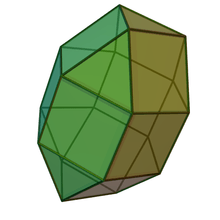Elongated triangular orthobicupola
In geometry, the elongated triangular orthobicupola or cantellated triangular prism is one of the Johnson solids (J35). As the name suggests, it can be constructed by elongating a triangular orthobicupola (J27) by inserting a hexagonal prism between its two halves. The resulting solid is superficially similar to the rhombicuboctahedron (one of the Archimedean solids), with the difference that it has threefold rotational symmetry about its axis instead of fourfold symmetry.
| Elongated triangular orthobicupola | |
|---|---|
 | |
| Type | Johnson J34 - J35 - J36 |
| Faces | 2+6 triangles 2x3+6 squares |
| Edges | 36 |
| Vertices | 18 |
| Vertex configuration | 6(3.4.3.4) 12(3.43) |
| Symmetry group | D3h |
| Dual polyhedron | - |
| Properties | convex |
| Net | |
 | |
A Johnson solid is one of 92 strictly convex polyhedra that is composed of regular polygon faces but are not uniform polyhedra (that is, they are not Platonic solids, Archimedean solids, prisms, or antiprisms). They were named by Norman Johnson, who first listed these polyhedra in 1966.[1]
Volume
The volume of J35 can be calculated as follows:
J35 consists of 2 cupolae and hexagonal prism.
The two cupolae makes 1 cuboctahedron = 8 tetrahedra + 6 half-octahedra. 1 octahedron = 4 tetrahedra, so total we have 20 tetrahedra.
What is the volume of a tetrahedron? Construct a tetrahedron having vertices in common with alternate vertices of a cube (of side , if tetrahedron has unit edges). The 4 triangular pyramids left if the tetrahedron is removed from the cube form half an octahedron = 2 tetrahedra. So
The hexagonal prism is more straightforward. The hexagon has area , so
Finally
numerical value:
Related polyhedra and honeycombs
The elongated triangular orthobicupola forms space-filling honeycombs with tetrahedra and square pyramids.[2]
References
- Johnson, Norman W. (1966), "Convex polyhedra with regular faces", Canadian Journal of Mathematics, 18: 169–200, doi:10.4153/cjm-1966-021-8, MR 0185507, Zbl 0132.14603.
- http://woodenpolyhedra.web.fc2.com/J35.html